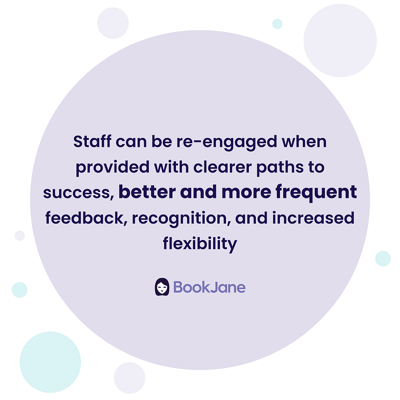
Given the high stress levels associated with jobs in healthcare, employee disengagement is not uncommon, but it is disruptive and expensive. The good news is employees are only disengaged until they are re-engaged. Here are strategies you can implement to help disengaged staff regain their motivation, reignite their passion and get them back to providing quality care.
1) Ask More Questions
It’s not enough to recognize that employees are disengaged. You have to dig deeper to discover why. Employee satisfaction surveys are a great way to take the temperature of the workplace, and drill down to those areas – workplace disorganization, personality conflicts, scheduling woes – that might be causing problems. Keeping surveys confidential is important, as some employees aren’t comfortable airing negative views, sharing criticisms, or admitting they’re having trouble staying motivated.

Get the pulse of employee engagement by surveying their views about procedures, management performance and teamwork. The answers will reveal which areas need targeted action plans for improvement.
2) Organize Frequent Check-Ins
Disengaged employees often report feeling disconnected from management or unsupported. Make a schedule to check in with staff weekly or monthly and stick to it. When managers make time for regular, one-one-one meetings, it tells employees their work is noticed and shows them they are valued.
And, since feedback is a two-way process, check-ins give employees a chance to fill managers in on workplace or personal issues, such as burdensome recordkeeping procedures or feelings of exhaustion, that could be turning into sources of disengagement for them. When managers build real relationships with employees, it’s easier to ask them about changes in their work patterns, like why they’re missing work or why they’ve stopped taking on new challenges. The key to engaging and re-engaging employees is always open dialogue – more of it, with more regularity.
3) Recognize Employee Efforts
When jobs well done are recognized and celebrated, it’s tempting for healthcare professionals to put in that extra effort again the next time. Employees need to be recognized for their contributions.
Annual performance reviews are necessary, but once a year is too infrequent for performance feedback and recognition. When recognition and constructive feedback is given on a regular basis, job improvement, which leads to job satisfaction, happens consistently. Consider adopting a recognition system or software platform, which lets management and staff recognize contributions big and small more often, with more people, by sharing comments, hat-tips and notes of thanks. Public recognition is also a great motivator. Recognizing a job well done at a staff meeting reinforces that value for the whole team.
Lastly, don’t forget about compensation reviews. When employees are consistently growing in experience, improving their skills and bringing added value to patients and the facility, salary increases are warranted, motivating and aid in employee retention.
4) Training and Development to Grow Professionally
Your most experienced staff are probably those who’ve been there the longest. The routine and lack of opportunity for growth can lead to disengagement. Employees can feel like they are stuck, stagnant and have no room for growth.
Help employees reach their potential by implementing training programs that keep employees learning new techniques or learning programs with invited speakers to talk about new healthcare research and innovations. build their skill sets, provide formal mentoring between seasoned and newer employees, coaching for improvement
Succession planning to recruit and prepare new leaders from among the current ranks boosts engagement and retention. Employees tapped for future leadership roles are highly motivated knowing they’re part of the organization’s plans moving forward.
5) Clear Organizational Goals
When employees have uncertainty about their duties or find themselves in disorganized workplace situations, it drains and saps their energy and drive. Employee engagement starts on day one, with a strong onboarding process that gives employees a clear and unambiguous sense of what their duties are and how they’ll be evaluated.
To stay engaged, it helps for employees to feel emotionally connected to the organization. Be explicit about the organization’s values and long-term goals and tell employees how they fit in – both as individuals and as a member of the team. Knowing and connecting to the facility’s social purpose and healthcare or child care mission can help counteract some of the day-to-day boredom and repetitiveness of the job. When the employee knows the facility is counting on them as individuals, it can be empowering.
6) Prioritize Work-Life Balance
When employees start to feel they have no life outside of work, or their work schedules are too rigid to allow them to handle pressures from their home and family lives, they can start to disengage. Healthcare facilities can help by making work-life balance a priority and providing flexibility to employees that recognize they have personal lives beyond the walls of the health or child care complex.
Disengaged staff can be re-engaged when provided with clearer paths to success, better and more frequent feedback, recognition, and increased flexibility. Implementing a comprehensive staff engagement plan will get them back to providing high quality care, faster.
For more insights on keeping employees engaged, read about current trends in staff disengagement in healthcare and discover the signs that show your employees are disengaged.
Learn how BookJane helps health care facilities improve shift fulfillment by 40%, dramatically decrease their time to fill shifts, and significantly reduce burdensome scheduling and administration time.






